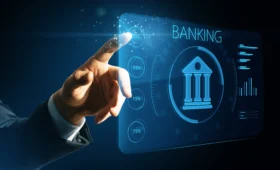The banking industry is rapidly evolving, driven by technological innovations and changing consumer needs. In 2025, digital banking, mobile payments, and financial technologies (fintech) are reshaping the way we interact with our money. This guide delves into the current state of banking, the changes to expect, and how to navigate the banking landscape in the coming years.
1. The Shift to Digital Banking
In 2025, digital banking is no longer a trend—it’s the standard. With the rise of online platforms, many traditional banking services are now accessible through mobile banking apps and web portals. Digital banking has made it easier than ever to manage accounts, transfer money, pay bills, and apply for loans.
- Online Banking: Provides services like checking balances, transferring funds, paying bills, and accessing loans via a secure web interface.
- Mobile Banking: Allows you to perform banking transactions directly from your smartphone. Mobile apps provide a convenient way to check balances, deposit checks, and make payments while on the go.
This shift to digital banking is part of a broader trend toward financial inclusion, enabling access to banking services for people in remote or underserved areas who may not have easy access to physical bank branches.
2. The Rise of Fintech
Fintech (financial technology) is revolutionizing how we handle financial transactions and services. From mobile wallets to peer-to-peer lending, blockchain, and cryptocurrency, fintech is democratizing access to financial services and increasing competition in the banking industry. Many fintech companies offer specialized financial services that complement traditional banking models.
- Peer-to-Peer Lending: Services like LendingClub and Prosper allow individuals to lend and borrow money without involving traditional banks. This type of lending often comes with lower interest rates and more flexible terms.
- Cryptocurrency Banking: With the rise of cryptocurrencies like Bitcoin and Ethereum, some banks and fintech companies are beginning to integrate digital currencies into their offerings. This provides new ways to manage money, invest, and make transactions using blockchain technology.
- Mobile Wallets and Digital Payments: Apps like PayPal, Venmo, and Cash App allow users to send and receive money, shop online, and pay bills seamlessly from their phones.
3. Traditional Banking vs. Digital Banking
While traditional banks continue to thrive, digital-only banks (also known as neobanks) are gaining traction. These virtual banks offer many of the same services as traditional banks but without the overhead of physical branches. Customers access all services through mobile apps and websites.
- Traditional Banks: Offer a wide range of services, including physical branches, ATMs, investment advice, and business banking solutions. They also provide security features, such as fraud protection, that customers rely on.
- Neobanks: Focus on providing streamlined, user-friendly services through mobile platforms. They typically offer lower fees and more flexible banking options, but they might lack some services like in-person banking or advanced investment products.
4. The Role of Artificial Intelligence in Banking
Artificial Intelligence (AI) is playing a growing role in the banking sector, making banking services more efficient and customer-friendly. AI is helping banks provide better services through personalized experiences, faster loan approvals, and enhanced fraud protection.
- Personalized Banking Services: AI algorithms analyze customer data to offer tailored financial products and services. For example, AI can suggest savings plans based on your spending habits or help you create a more efficient budget.
- Chatbots and Virtual Assistants: Many banks now employ AI-powered chatbots to provide customer service 24/7. These bots can handle routine inquiries, transaction history requests, and even help customers navigate the loan application process.
- Fraud Detection: AI can detect unusual patterns in banking transactions, allowing for more robust fraud prevention and faster identification of potential threats.
5. Mobile Payments and Digital Wallets
The mobile payment industry is booming, with users increasingly opting for digital wallets to manage their finances. Digital wallets allow users to store payment information, such as credit or debit cards, securely in their phones for quick transactions.
- Apple Pay, Google Pay, and Samsung Pay are popular mobile wallets that make it easy to pay for goods and services in-store or online without needing to swipe a physical card.
- Contactless Payments: NFC (Near Field Communication) technology allows users to make quick, secure payments simply by tapping their phone or card against a payment terminal. This is convenient for in-person transactions and is becoming widely accepted by merchants.
6. Banking Security in 2025
As the digital world continues to evolve, so does the need for strong banking security. In 2025, banks are implementing more advanced security measures to protect customers from fraud and identity theft. Some of these include:
- Biometric Authentication: Many banks now use fingerprint scanners, facial recognition, or voice recognition for added security when accessing accounts or authorizing transactions.
- Two-Factor Authentication (2FA): 2FA is becoming a standard security feature, requiring users to verify their identity with something they know (like a password) and something they have (such as a smartphone).
- Blockchain Security: Banks and fintech companies are experimenting with blockchain technology to create secure, tamper-proof systems for storing and transferring money.
7. Banking Regulations and Customer Protection
With the growing use of digital platforms, regulatory bodies are adapting their rules to ensure customer protection and maintain the stability of the banking system. Governments are implementing regulations that address everything from data protection to consumer rights and anti-money laundering measures.
- GDPR: The General Data Protection Regulation (GDPR) in the EU mandates strict rules regarding how banks collect and store customer data, ensuring that privacy is a top priority.
- Consumer Protection Laws: In many countries, consumer protection laws help safeguard customers from unfair fees, deceptive practices, and fraud.
8. The Future of Banking: What to Expect
The future of banking looks set to be increasingly tech-driven, with innovations like AI, blockchain, and digital currencies paving the way for more personalized, efficient, and secure financial services. As digital banking continues to gain ground, traditional banking institutions will likely have to adapt to stay competitive. However, one thing remains clear: the future of banking is in digital transformation, and it promises to make financial services more accessible, affordable, and convenient for everyone.
Conclusion
The banking industry is evolving quickly, and understanding the new trends and technologies can help you make better financial decisions. Whether you’re using digital banking services, exploring the world of fintech, or taking advantage of new payment systems, staying informed about the changes in the banking landscape will empower you to manage your finances more effectively.
As mobile banking, AI, and cryptocurrency continue to reshape the industry, customers will have more options than ever to manage their money. The key is to choose the tools and services that best fit your financial goals and needs.




